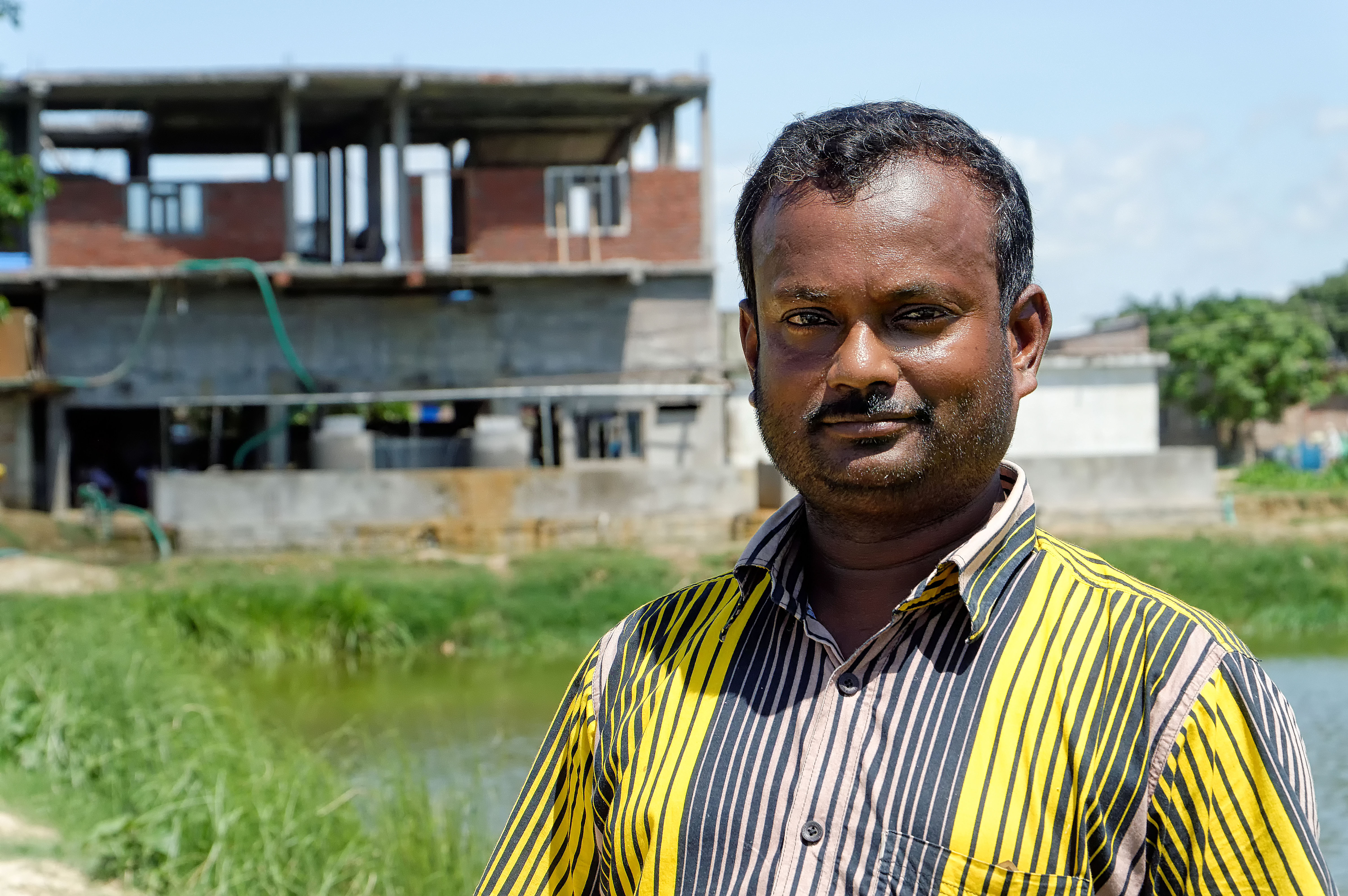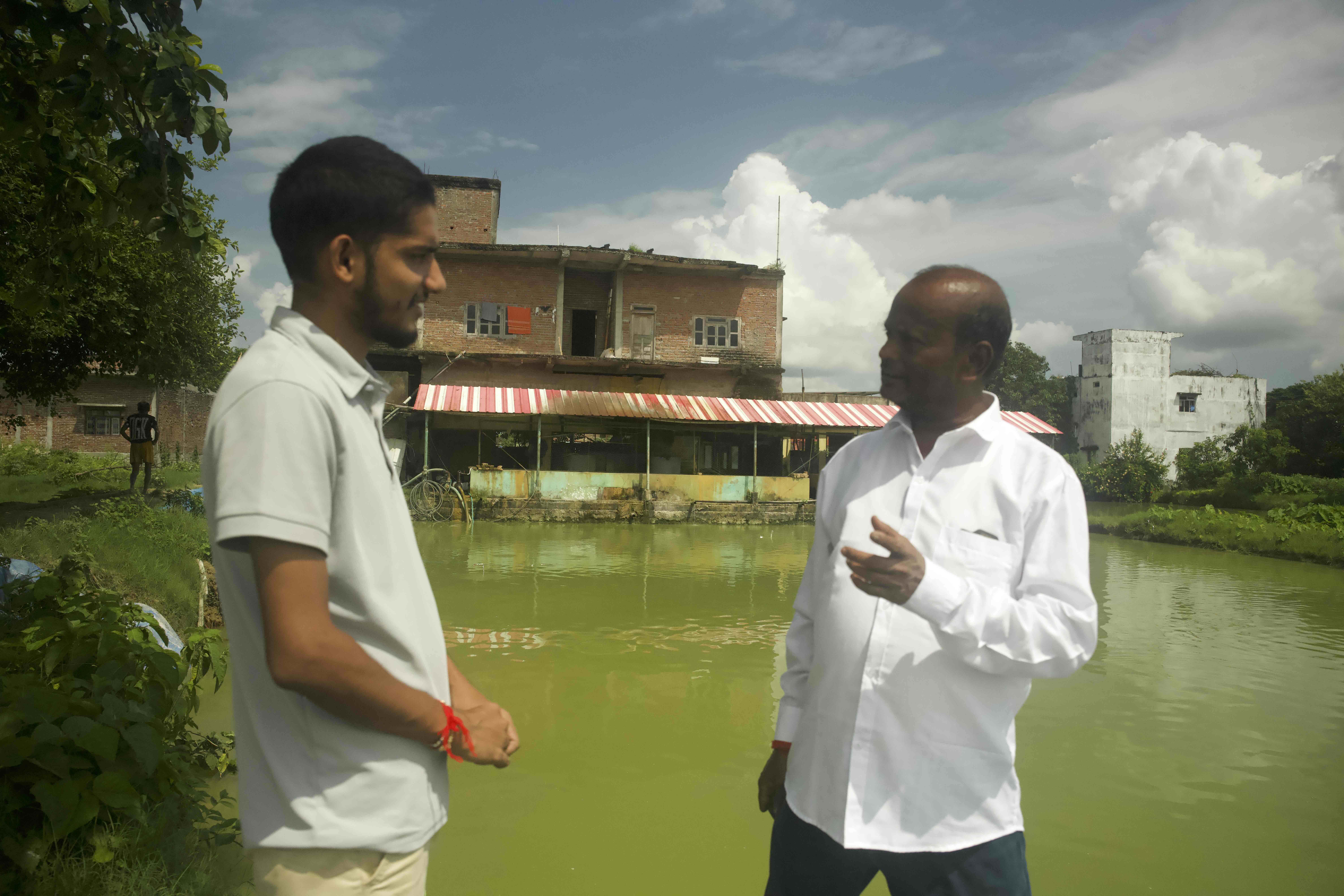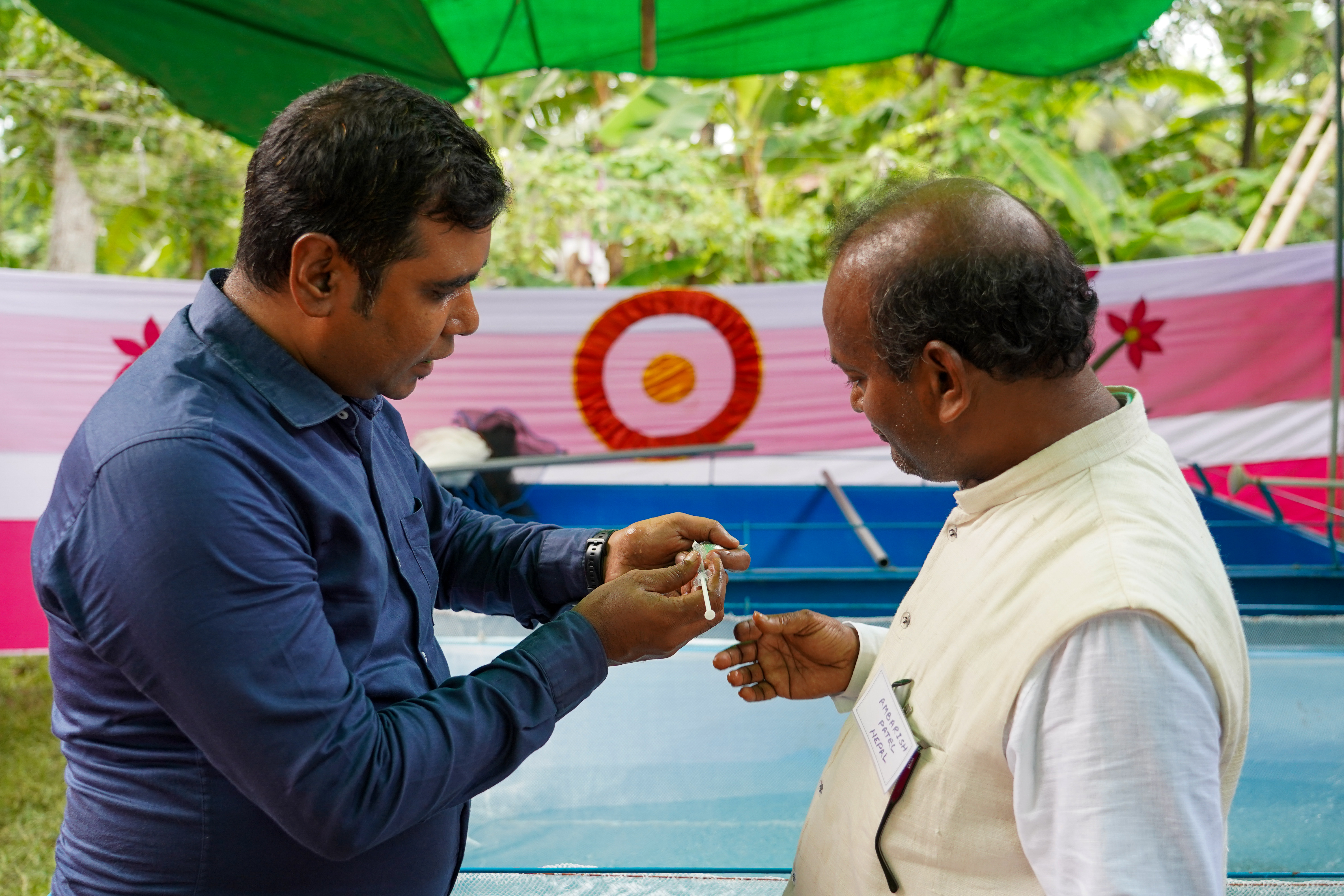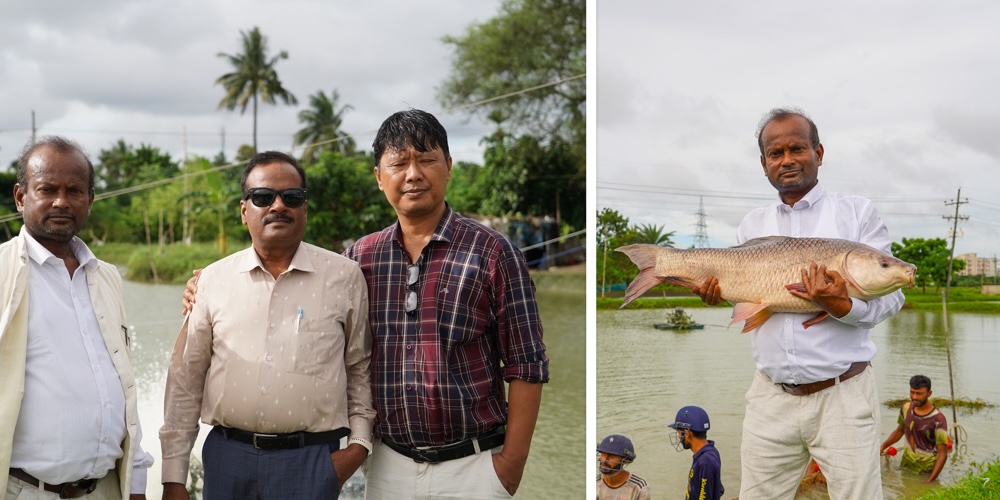
- Cross-border exchange of aquaculture knowledge and skills is transforming local hatcheries into regional models for innovation, quality seed production, and farmer training.
- Strategic diversification into new species and farmer services is strengthening market resilience, improving farmer incomes, and contributing to better nutrition outcomes.
- WorldFish, under the CGIAR Scaling for Impact (S4I) program, is building on decade-long Nepal-Bangladesh partnership outcomes to further scale out access to improved fish genetics in Nepal and open pathways for greater impact through sustainable aquaculture.
“In 2013, a WorldFish-organized visit to Bangladesh transformed how I run my hatchery, introducing me to advanced technologies at the Bangladesh Fisheries Research Institute and leading private hatcheries in Mymensingh and Barishal.” Ambarish Patel Patanawar, Award-Winning Hatchery Entrepreneur, Nepal.
A Decade Ago: Nepal’s Seed Supply Challenge
Over a decade ago, Ambarish Patel Patanawar was a hatchery operator in Nawalparasi District, Nepal, striving to improve the quality of fish seed for smallholder farmers. At the time, Nepal lacked a reliable supply of hatchery-produced seed for key species like carp. Farmers depended heavily on fingerlings imported from India or transported from distant parts of Nepal, which often arrived late, in poor condition, and were poorly suited to local ponds. This led to low survival rates, poor growth performance, and limited profitability.
The Turning Point: Learning from Bangladesh
The breakthrough came in 2013 and 2014, when Ambarish participated in two WorldFish-facilitated exposure visits to Bangladesh under the Agriculture and Nutrition Extension Project (ANEP), funded by the European Union (EU).
In his first visit in 2013, he trained at the Bangladesh Fisheries Research Institute (BFRI) and at the private hatchery of Mr. Kadir, an innovative aquaculture entrepreneur. He learned advanced breeding techniques for common carp, rohu, tilapia, and pangasius, and visited farmer ponds to observe how high-quality seed performed in pond and rice–fish systems.
“Mr. Kadir was incredibly generous in showing me practical methods, from small hatching jars to improved spawning protocols, that we had never seen in Nepal. I returned home determined to apply them immediately.”
The second visit in 2014 gave him several days of hands-on work in advanced hatcheries in Mymensingh and Barishal, deepening his skills in hatchery operations and broodstock management.
The collaboration evolved into a continuous mentorship loop when Dr. Gulam Hussain from BFRI and Mr. Kadir later visited Nepal, providing on-site guidance at Ambarish’s hatchery. WorldFish, through ANEP, further strengthened his connections with the Central Fisheries Promotion and Conservation Center (CFPCC) and Tribhuvan University. Both institutions began using his hatchery for research trials and technical training, further establishing it as a trusted local hub for innovation and knowledge sharing. These partnerships opened doors for Mr. Patel to receive multiple trainings, in-country exposure visits, technical support, and government subsidies, all of which strengthened his hatchery operations.

Building a Market Presence
By 2014, Ambarish’s hatchery was producing multiple carp species and had expanded into a modern three-story facility with integrated feed production and aeration systems. In 2016, he diversified into pangasius seed production, a strategic move that opened up a fast-growing market segment in Nepal. Pangasius offered faster growth rates, year-round production, and strong consumer demand, creating a steady revenue stream and positioning him as a frontrunner in introducing commercially viable new species to the country. His pioneering work earned him a national award named the World Food Day Award for fish seed production.
Today, alongside pangasius, he produces rohu, catla, mrigel, common carp, grass carp, silver carp, and bighead carp. In 2024, his hatchery produced 2.0 million fingerlings, supplying more than 1,200 farmers—about 50% of them women and youth—resulting in an estimated 800 tons of fish produced annually by his clients, valued at roughly USD 1.23 million.

This scale and reach reflect not only his technical expertise but also the market and enterprise skills honed through ANEP training in the Participatory Market Chain Approach (PMCA) and business management, which he has long applied to running his hatchery and advising farmers on production, markets, and species selection.
His hatchery has also become a training hub for the Institute of Agriculture and Animal Science (IAAS) Paklihawa Campus of Tribhuvan University, hosting visits for faculty and students, and supporting collaborative research.
A New Market Disruption
The Directorate of Fisheries Development, with FAO support, imported pure-line carp fingerlings of grass carp, common carp, silver carp, and bighead carp from China in 2011. These were reared into broodstock in government hatcheries and, starting in 2016, bred and distributed as improved fingerlings to private nurseries. However, hatcheries had to rear these fingerlings into broodstock before using them for seed production—a process taking several years. For operators like Mr. Patel, who lacked sufficient pond space for brood development and was already producing quality seed from existing broodstock, replacing them with immature fish was both time-consuming and commercially risky, limiting early adoption.
In recent years, however, many new hatcheries have entered the market, and those that adopted the improved broodstock are now producing large volumes of high-quality carp seed. This shift in farmer preferences has eroded Ambarish’s carp seed client base, prompting him to explore strategic changes to remain competitive. As part of this shift, he intensified his focus on pangasius seed production, where market demand was rising and competition was less intense.
From SIS to G3 Rohu: Strengthening Regional Aquaculture Links
In 2025, Ambarish returned to Bangladesh not as a trainee but as a peer to join S4I’s advanced training on hatchery-based mass seed production of Small Indigenous Fish Species (SIS). These nutrient-rich, locally adapted species are central to nutrition-sensitive aquaculture, improving dietary diversity in rural households and creating income opportunities for women and youth. The event, jointly organized by S4I and CGIAR Sustainable Animal and Aquatic Foods (SAAF) programs, brought together hatchery experts from Nepal, Bangladesh, Kenya, and Cambodia to share innovations, address policy challenges, and strengthen regional partnerships.
“It feels like coming full circle. Ten years ago, I came here with questions. Now, I’m here to explore what’s next.”
During the training, Ambarish explored breeding protocols for high-value SIS species and assessed their adaptability to Nepal’s aquaculture systems and markets.

As part of the program, participants visited the Carp Genetic Improvement Program (CGIP) site to learn about Generation 3 (G3) rohu, a strain known for faster growth, better feed efficiency, and higher farmer returns. Discussions during the visit highlighted that introducing G3 rohu into Nepal would require enabling policies for cross-border broodstock movement and strict adherence to biosafety protocols.
Recognizing the potential, Ambarish engaged a Nepali government officer and a Tribhuvan University academic who joined the visit in exploring how Nepal could access such improved broodstock. The discussions included the possibility of establishing a regional genetic improvement network—with active government engagement from both sides—to enable responsible broodstock sharing and strengthen collaboration for sustainable aquaculture development across South Asia. This vision aligns with S4I’s goal of scaling CGIAR innovations across countries and regions.

Looking Ahead: Turning Challenge into Opportunity
Ambarish’s next phase of growth builds on his resilience and ability to adapt proven ideas into his own context. His priorities include:
- Upgrading carp and pangasius broodstock so farmers can get better-quality seed that meets national standards and increases their earnings.
- Expanding pangasius production to meet growing local market demand by ensuring the easy and consistent availability of quality pangasius seed.
- Introducing SIS in hatchery production, starting with pilots, as part of a nutrition-sensitive aquaculture approach, helping families eat better, improving diets for children, and creating new income streams for women and youth.
- Working with government officers and trusted partners to bring in improved fish like G3 rohu through proper regional cooperation, legal broodstock movement, and biosafety checks, while ensuring farmers get the training they need to raise them well.
By staying close to farmers, building on government advice, and linking with regional efforts, Ambarish aims to make his hatchery a trusted source for quality seed and practical knowledge, showing how local initiative and strong partnerships can deliver real impact.
Vision & Call-to-Action
Ambarish envisions a future where all 130 hatcheries in Nepal, 119 privately owned and 11 government-run, can consistently supply high-quality carp, pangasius, and SIS seed. This would reduce dependence on imports, diversify production, and expand nutrition-sensitive aquaculture that improves diets in rural and peri-urban communities. The benefits could reach approximately 200,000 fish-farming households nationwide, enhancing food security and generating new income opportunities.
Achieving this vision will require strong institutional backing. Based on his discussions with fisheries officials, Ambarish sees the need for government and regional cooperation to establish legal pathways for broodstock exchange, ensure biosafety compliance, and invest in hatchery upgrades and farmer training.
With coordinated support from government, donors, and private partners, his hatchery and other leading operations in Nepal can become models of quality, innovation, and farmer trust.

